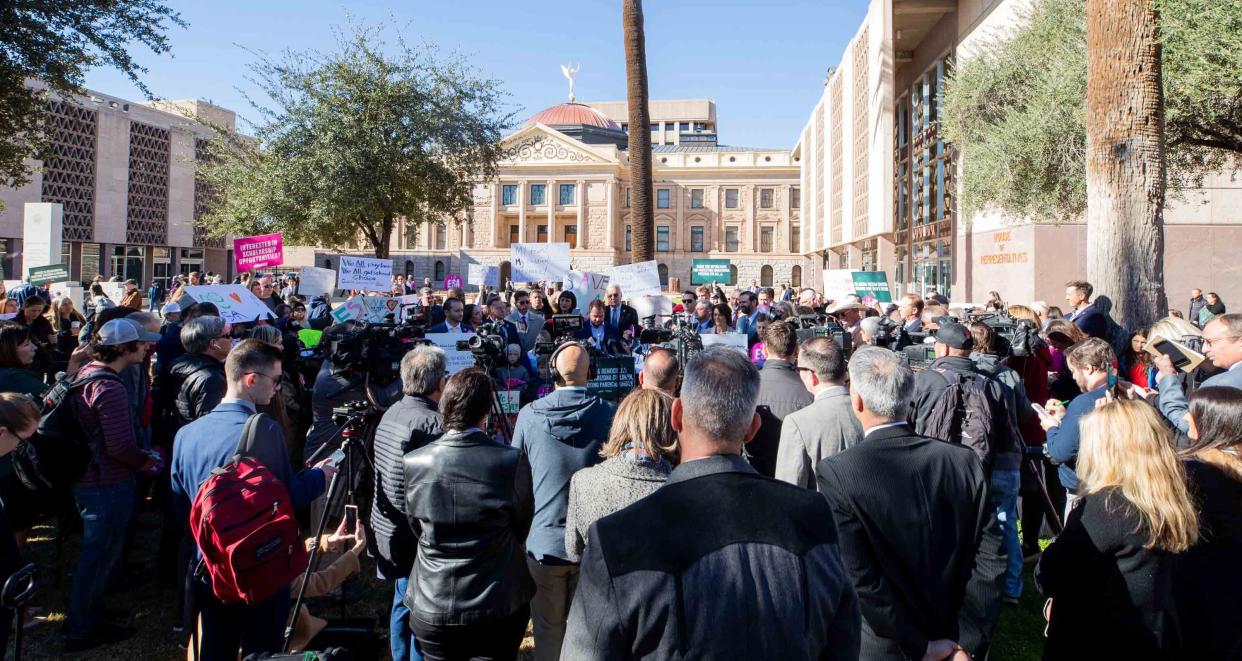Numbers don't lie: Republican lawmakers are utterly wrong about school vouchers

With Arizona facing a $835 million budget deficit, now seems like a good time to talk about the impact of the universal voucher program on the state budget.
You know, the runaway program now approaching $900 million — the one we are assured has nothing to do with our $835 million deficit?
Republicans assure us Empowerment Savings Accounts actually save the state money, even as they allow legions of poor children to flee failing public schools.
“This deficit is squarely on Katie Hobbs’ shoulders,” Sen. Jake Hoffman said on Monday, during a rally of ESA supporters. “This is not a problem with ESAs. ESAs save taxpayers’ money.”
Maybe, when you lump in all sources of federal and local funding.
But they’re a drain on the state general fund — the one that is $835 million in the red this year, with another $879 million deficit expected next year, according to new projections from the Joint Legislative Budget Committee.
Most students live in wealthy ZIP codes
A pair of reports this week make it clear that ESAs are costing the state hundreds of millions of dollars. And those poor kids in mid-flight from rotten public schools?
It seems more than half of the students going to private school on the public’s dime live in the state's toniest ZIP codes.
According to an analysis by ABC 15’s data whiz, Garrett Archer, 52% of ESA recipients live in the top quarter of affluent areas, with median incomes ranging from $81,000 to $178,000.
The majority come from the Valley’s outer suburbs, with the most ESA recipients in a single ZIP code right there on Hoffman’s home turf in Queen Creek.
Just 5% come from ZIP codes where the median income is under $49,000, Archer reports.
ESAs don't save Arizona money, either
Yes, but ESAs are saving us money, right?
We’ve long heard from ESA supporters that a basic school voucher is set at 90% what the state would pay to send a student to a public school. What they don’t tell us is that that 90% figure is based on what the state pays charter schools.
The state allocates more money per student to charters than to traditional public schools.
As a result, the state actually is investing more in the education of a student getting an ESA than it does in the education of a child attending a traditional public school, according to a recent report by legislative budget analysts.
Kids from property-rich areas cost us most
Turns out the state spends a whopping $700 more on a non-special needs ESA student in kindergarten through eighth grade than it invests in a student who attends most K-8 public schools — the large districts that receive basic state aid.
ESA high schoolers get $900 more than teens in a regular public school.
Then there are the 31 property-rich districts that don’t get any basic state aid. Local taxpayers cover the cost.
Hobbs proves she's ready: To flip the Legislature
But when a child from, say, Scottsdale or Cave Creek gets an ESA, suddenly state taxpayers must pick up the tab — $6,900 for a K-8 ESA and $7,700 per high school student where before we were paying nothing.
Meanwhile, most of the 73,000 kids getting ESAs were never in public school and thus are a new state expense.
GOP doubles down on cost-savings line
And so the program that was originally projected to cost us $65 million this year has now pushed past $800 million, with too few controls and too little information about how our money being spent.
Hobbs has offered a mostly modest set of reforms, including a proposal that our money should no longer be used to educate children on the ski slopes or at trampoline parks or dojos.
Republicans immediately blasted her proposal as “dead on arrival” and reached for their favorite old bromide — the one intended to placate the masses and end any debate about even modest controls on the Arizona's runaway ESA program.
“By and large,” House Speaker Ben Toma told 12News, “the state actually saves money for every child that switches over to an ESA.”
Um …
Reach Roberts at laurie.roberts@arizonarepublic.com. Follow her on Twitter at @LaurieRoberts.
Support local journalism: Subscribe to azcentral.com today.
This article originally appeared on Arizona Republic: ESAs largely help rich kids and cost Arizona money on education

